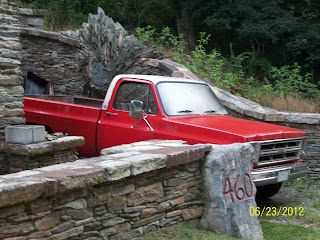Dog walks through history
During our stay at
Camp Hill Bed and Breakfast in Harper's Ferry, before breakfast, Mabel and I walked a variety of
loops that began and ended at the Carriage House. On Friday morning, we
traveled one block down McDowell Street, turned right along Fillmore Street.
The Carriage House at Camp Hill is a pet friendly, family friendly destination.
Loop 1: Storer College
Tony Catanese,
proprietor of Camp Hill Bed and Breakfast Inn,
had suggested that I look for a
field with a canon. Behind Camp Hill, on the corner of Fillmore and Jackson,
Mabel posed behind this Civil War era canon.
Across the street
from the canon, Mabel and I explored the
grounds of Storer College, site of the
first open meeting of the Niagara Movement on American soil, organized by W.E.B.
Dubois.
Pithy historical displays along
the path presented the ironic history
of separate but unequal schools in a segregated society which used rights articulated in the Declaration of Independence as the basis for armed
struggle. Mabel and I stopped at all of the historical displays.
Mabel and I paused
to watch the ongoing painting and restoration of the old Storer College
facilities, which has been repurposed as the Mather Training Center for the
National Park Service.
Debates over funding
and the role of higher education in our society that played out at Storer
College paralleled current debates playing out over the future of higher
education playing out at the University of Virginia .
While educational
funding was easier to secure for
programs that produced "hands" at Storer College, such as
industrial arts, funding for programs
that benefited "minds," such as chemistry, was generally unavailable.
In today's ongoing
debate at the University of Virginia over the ouster of President Sullivan by the Board of
Regents, President Sullivan's defense of the unprofitable classics department
played a role in her ouster.
Did W.E.B. Dubois's
insistence on providing a Liberal Education over more marketable programs
eventually lead to future funding problems at Storer College?
Tony had shown me a
Civil War picture of Union Soldiers lining up in parade formation on a field
which is now part of the Mather Training Center for the National Park Service.
That field became Storer College's football
field.
An uneven playing field!
Hikers are welcome
on this friendly stopping place along the Appalachian Trail located at the
corner of Jackson and Washington Streets.
After making a deposit in trashcans at the Appalachian Trail Conservancy, Mabel and I paused in front of this sign.
Back on the porch,
Mabel felt like a queen. In a few minutes, the Catanese family would be
delivering the bacon. It's a dog's life!
Loop 2: Washington Street
Early Saturday
morning, Mabel and I stopped in front of
this stone arch a few blocks down from Camp Hill on Washington Street.
A red Chevy Truck
was parked in the driveway.
Mabel is partial to
Chevy trucks.
Cooled by
thunderstorms the evening before, it was a pleasantly cool morning, so we
continued the rest of the way down
Washington Street.
Mabel was a good
sport as she posed often for photo
opportunities.
We found this
cut-through and made our way down to Potomac Street.
The smells wafting
from Hannah's Train Depot on Potomac Street, which specializes in barbecue,
were unforgettable. Here's another reason to come back to Harper's Ferry.
After descending the stairway connecting Washington Street to Potomac Street, Mabel
posed by the memorial of Private Luke Quinn, the only Marine to perish during John Brown's raid.
On
Friday night, during his Ghost Tour of Harper's Ferry, Rick
Garland, a living historian,
evoked a side of Harper's Ferry
generally missing from the history
books. Garland reflected on historical
and social factors which defined Harper's Ferry's role in American History
before John Brown's Raid on the National Armory during the Civil War. He
described how, during the French Revolution, after French suppliers stopped
supplying weaponry to America, George
and his younger brother Charles Washington campaigned on behalf of Harper's Ferry as the site for a
southern gun factory and hub of transportation and commerce. The National Park
Service describes the role of George Washington in
its teacher's packet. During its heyday, according to Garland,
Harper's Ferry was defined by 3 W's: Weapons, Whiskey, and Women. Saloons played
a pivotal, but often unacknowledged role in the historic events which unfolded
along Potomac Street.
Mabel and I
paused in front o f the site of Dr.
Brown's cave, the significance of which was described on Friday night by Rick
Garland of "O' Be Joyfull Historical
Tours & Entertainment." For a
virtually verbatim description of the story about Dr. Brown that Garland
shared with his audience, check out
"Musings of a Ghost Adventurer by " Melissa Telesha at
My camera lost power
at Hog Alley.
During the Ghost
Tour, Rick Garland described how drunken townspeople cheered the slow and
agonizing death of Dangerfield Newby. Newby was stabbed repeatedly, dismembered
alive, then dragged to Hog Alley, where his body was fed to wild hogs in retribution for his role in John
Brown's raid on Harper's Ferry before a cheering mob. Odd occurrences at Hog
Alley have been attributed to Newby's
ghost which is said to haunt the place of his horrific death. Garland described
a belief that ghosts draw energy from the surrounding environment, and that
ghosts drain batteries.
Back at the Carriage
House at Camp Hill, Tony would soon be delivering his signature omelets. Mabel would be getting her share.
Mabel and I enjoyed
our dog walks through history. I was reminded of something Roger Slakey, one of
my favorite professors at Georgetown University once shared with his class:
"It's one thing to experience the Shenandoah by car and quite another to experience
the Shenandoah on foot." Mabel
would agree.




















No comments:
Post a Comment
My goal is to engage in civil conversation.